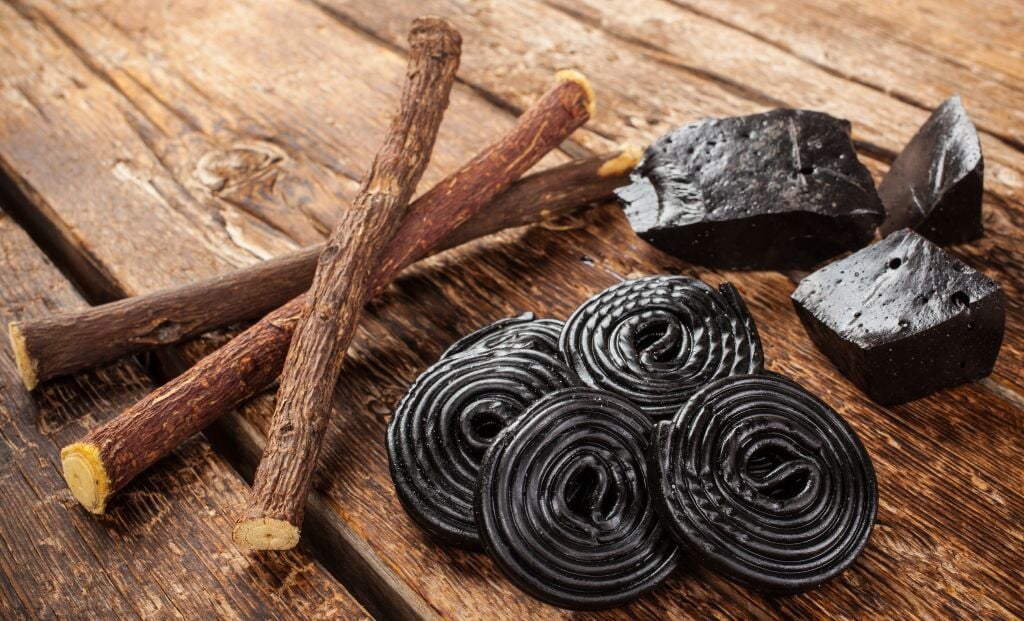Description
Ingredients
Licorice is best known in the modern world as a tasty, tangy, sweet and delicious treat!
While licorice candy is a favorite of many, few people know that licorice has a long history of use as a medicinal herb, dating back to Ancient Egypt where it was made into a sweet drink for the pharaohs.
Also known as “sweet root”, licorice was one of the oldest herbal remedies in ancient Assyria and other major Mesopotamian civilizations where it was used to treat coughs, liver disorders and even food poisoning [1].
In Traditional Chinese Medicine (TCM), licorice root is considered a synergist and is used to bring together many classic healing formulas for respiratory and digestive health.
Even though the licorice plant (botanical name: Glycyrrhiza glabra) is native to Southwest Asia and the Mediterranean, it’s been cultivated in Europe since the dawn of the first millennium. The Benedictine monks of Italy used the herb to boost digestion and prevent diuretic problems since as early as the year 1000 [1].
Today licorice is no longer limited to monks and the upper classes, you can find many varieties of licorice in the market where it’s commonly used as a flavoring in candy, beverages, pastries, gelato, and a myriad of other food products.
Unfortunately, however, licorice’s medicinal properties have been mostly forgotten over the years.
So, let’s acquaint you with the therapeutic properties of licorice root and discuss why you may want to incorporate this healing plant into your lifestyle.
What Is the Difference Between Licorice and Licorice Root?
When you think of licorice, you probably think of flavored candy that comes in the form of black or red chewy ropes or tubes. Licorice candy has a very sweet flavor that people either love or hate.
As a flavoring agent, licorice is also used to flavor beers (case in point: strong beers like Jägermeister) and to sweeten foul-tasting medicines like Nyquil.
However, many “licorice” candies and food products in the United States do not contain actual licorice. Food manufacturers typically use anise oil instead as it smells and tastes just like licorice [1].
Licorice root, on the other hand, comes from the root of the licorice plant, a perennial herb that’s a member of the legume family. Since the beginning of recorded history, humans have made use of licorice as a medicinal remedy.
But what exactly are the medicinal properties of licorice?
The primary active compound in licorice root is glycyrrhizin which endows the plant with its well-known sweet taste, as well as antioxidant, anti-inflammatory, anti-carcinogenic, and antimicrobial properties [2]. As such, current research has echoed some of the traditional uses of licorice root as a medicinal remedy -- many of them related to digestive and skin health.
The potential benefits of licorice root include:
1. May help heal peptic ulcers
Chinese herbariums describe licorice as an agent to “improve the tone of the digestive system.” Modern research has found licorice useful in treating peptic ulcers that may develop in the stomach, lower esophagus, or small intestine. These ulcers are commonly caused by H. pylori bacteria which can damage the protective lining of your gut over time, allowing stomach acid to create open sores.
The antibacterial and anti-inflammatory actions of licorice root can significantly reduce the presence of H. pylori in the gut, allowing the sores to heal and also easing the symptoms [2].
2. May reduce acid reflux, heartburn and indigestion
Licorice root may be used to assuage symptoms of gastroesophageal reflux disease (GERD) including acid reflux, upset stomach and heartburn. Similarly, if you constantly suffer acid reflux or heartburn, taking licorice tea or supplements can be more effective at reducing symptoms than commonly used antacid [1,5].
3. May lower the risks of certain cancers
Cancer is still a major health issue worldwide. As such, licorice root extract has been studied for its anticancer benefits—owing to its numerous antioxidant and anti-inflammatory properties. While its anticarcinogenic properties are still under study, some scientists believe licorice may have preventative benefits against certain cancers, primarily colorectal cancer and leukemia [2,3].
Licorice inhibits Epstein-Barr virus expression, which is associated with certain cancers. The sweet root extract may also act as a shield against carcinogen-induced DNA damage [2].
That said, licorice has also proven useful in treating oral mucositis – painful mouth sores that come as a side effect of chemotherapy and radiation [2,3].
4. May ease upper respiratory conditions
The glycyrrhizin compounds in licorice root can help relieve asthma symptoms, especially when used in conjunction with modern asthma treatments. Additionally, licorice root has both anti-inflammatory and antimicrobial effects that can help ease and fight upper respiratory infections.
Licorice can also be used to reduce the incidence and severity of postoperative sore throat that results from having a breathing tube inserted into the windpipe during surgery [4].
5. May fight skin inflammation and infection
Licorice root extracts have demonstrated anti-inflammatory, antibacterial, and antiviral effects, which are useful in treating a variety of skin conditions including acne and eczema [2].
The root has shown to be effective against bacteria that infect the skin like Staphylococcus aureus, which can cause skin infections, such as cellulitis, and folliculitis.
6. May help treat Hepatitis C
Glycyrrhizin demonstrates antiviral activity against hepatitis C, a virus that infects the liver causing long-term liver damage when untreated. The compound could also inhibit the development of liver cancer that results from hepatitis C infection [4].
7. Adaptogen-like (anti-stress) properties
While licorice root is not an adaptogen, the plant does exhibit some supportive adaptogen-like effects. For one, licorice protects the thymus and adrenal glands from exhaustion and the stress hormone cortisol [2].
It can also be useful for weight loss as taking licorice root extract on the regular can result in the reduction of the superficial fat layer underneath your skin [2].
Is It Safe to Take Licorice Root Every Day?
The dosage of licorice depends on the medical condition that needs treating. However, the recommended therapeutic dose is 250 to 500mg or 20% glycyrrhizin [2]. Any dosage above this can cause potassium levels to drop which could result in abnormal heart rhythms, high blood pressure or other heart problems.
Some of the ways you can safely consume licorice are:
- Mix the herb with a skin-friendly gel to help with eczema and other skin conditions
- Dip loose herbs in hot water to make tea
- Take licorice supplements according to the instructions on the package
As long as you don’t exceed the recommended dosage, licorice is relatively safe to consume but caution is advised for hypertensive persons and those prone to fluid retention. Licorice is not safe for consumption during pregnancy and breastfeeding [2].
Does Licorice Root Give You Energy?
Licorice root has been found to regulate cortisol levels in the body, preventing the exhaustion of your adrenal glands. One of the consequences of this action is an increase in energy and a reduction in fatigue levels [2]. Unlike caffeine, licorice works gently to give your body the boost in energy it needs.
So, next time you’re feeling a little worse for wear, substitute the double espresso for some licorice root tea or a licorice supplement.
In ancient times licorice was made into a drink for easy consumption. Now, it’s available in liquid, capsule, and powder forms, making it very easy to incorporate into your diet.
Licorice root a primary ingredient in Lean Factor’s Peak Male for men, EmpowHER for women, and the Nootropic Brain Booster, Limitless Mind.
References
- Lee, M. R. "Liquorice (Glycyrrhiza glabra): the journey of the sweet root from Mesopotamia to England." The journal of the Royal College of Physicians of Edinburgh 48, no. 4 (2018): 378-382.
- Yance, Donald R. Adaptogens in medical herbalism: elite herbs and natural compounds for mastering stress, aging, and chronic disease. Simon and Schuster, 2013.
- Bode, Ann M., and Zigang Dong. "Chemopreventive effects of licorice and its components." Current Pharmacology Reports 1, no. 1 (2015): 60-71.
- Honarmand, Azim, Mohammadreza Safavi, Amine Safaei Arani, and Omid Shokrani. "The efficacy of different doses of liquorice gargling for attenuating postoperative sore throat and cough after tracheal intubation." European Journal of Anaesthesiology| EJA 33, no. 8 (2016): 595-596.
- Irani, Mahboubeh, Marziyeh Sarmadi, and Françoise Bernard. "Leaves antimicrobial activity of Glycyrrhiza glabra L." Iranian journal of pharmaceutical research: IJPR 9, no. 4 (2010): 425.
Licorice Root has been revered for centuries for its versatile health benefits, which include potential improvements in digestive health, immune system support, and stress relief. This comprehensive guide walks you through seven key benefits, as well as crucial information on safe dosing protocols. Uncover the underlying mechanisms that may make Licorice Root a potent addition to your wellness regimen. By understanding its bioactive compounds and their interactions with the body, you can make an informed choice on how to integrate this ancient herb into your health strategy.
Excerpt
Licorice Root has been revered for centuries for its versatile health benefits, which include potential improvements in digestive health, immune system support, and stress relief. This comprehensive guide walks you through seven key benefits, as well as crucial information on safe dosing protocols. Uncover the underlying mechanisms that may make Licorice Root a potent addition to your wellness regimen. By understanding its bioactive compounds and their interactions with the body, you can make an informed choice on how to integrate this ancient herb into your health strategy.



 Men's Health
Men's Health
 Women's Health
Women's Health
 Anti-Aging
Anti-Aging
 Brain Health
Brain Health
 Sports Performance
Sports Performance
 Immune Health
Immune Health
 Weight Loss
Weight Loss
 Reduce Stress
Reduce Stress




 Compare Peak Male
Compare Peak Male
 Rewards
Rewards
 Our Product Packaging
Our Product Packaging
 Contact Us
Contact Us






